THE TRAEGER UNIVERSITY
Traeger Brothers product descriptions.
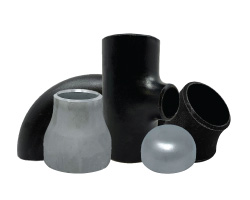
Butt Weld Fittings
Butt Weld fittings are used in piping systems to change direction, branch off into multiple directions, increase or decrease the diameter of the line or to connect equipment. These fittings are manufactured from either seamless or welded pieces of pipe or from steel plate. Butt Weld fittings are designed with beveled ends that allow for a weld to be completed around the entire fitting increasing the strength of the connection. Butt Weld fittings are preferred due to their ability to minimalize turbulence and reduce the chances of leakage.
Butt Weld fittings match the nominal size and schedule of pipe. Fittings are available in nominal sizes from ½” to 72” in diameter and schedule 10 to schedule 160, STD, XH and XXH. Butt Weld fittings are manufactured in accordance with ASME B16.9.
Fitting Types
- 45° Elbow – Short & Long Radius
- 90° Elbow – Short & Long Radius
- 180° Return Bend – Short & Long Radius
- Cap
- Concentric Reducer
- Eccentric Reducer
- Reducing Tee
- Stub End
- Tee
Common Materials
- Carbon Steel
- Low Temp Carbon Steel
- High Yield Carbon Steel
- Chrome Alloys
- Stainless Steel
- Exotic Metals
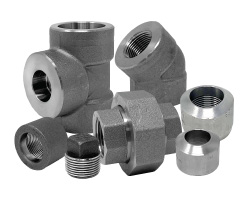
Forged Steel Fittings
Forged Steel fittings are typically used in small bore piping systems, generally below 4” in diameter. These fittings are formed from a solid piece of steel making them stronger than cast fittings. Forged Steel fittings are manufactured with either a socket weld or threaded end connection. Fittings are either filet welded to the pipe or screwed on depending on their end connection.
Socket Weld Forged Steel Fittings
Socket Weld fittings are available in nominal sizes from 1/8” to 4” in diameter. They are available in 3000#, 6000# and 9000# pressure classes.
Threaded Forged Steel Fittings
Threaded fittings are available in nominal sizes from 1/8” to 4” in diameter. They are available in 2000#, 3000#, 6000# and 9000# pressure classes.
Socket Weld and Threaded forged steel fittings are manufactured in accordance with ASME B16.11.
Fitting Types
- 45° Elbow
- 90° Elbow
- Bushing
- Cap
- Coupling
- Cross
- Half Coupling
- Lateral
- Plug (Round, Square, Hex Head)
- Reducing Coupling
- Reducing Tee
- Tee
- Union
Common Materials
- Carbon Steel
- Normalized Carbon Steel
- Low Temp Carbon Steel
- Chrome Alloys
- Stainless Steel
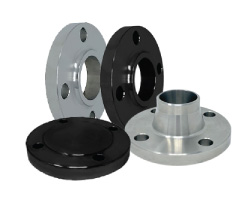
Flanges
Pipe Flanges are used to connect pipe, valves, pumps and other equipment to form a complete piping system. A flange is bolted to the piping equipment with stud bolts. Gaskets are used between flanges to seal the connection. Flanged connections can be disassembled when necessary allowing for easy access to perform routine maintenance or complete a repair.
The nominal size of the flange is designed to match the nominal size of the pipe it is being connected to. Flanges are available in a variety of pressure classes from 150# to 2500#. Weld Neck and Socket Weld flanges also require the schedule to be called out to ensure the bore of the pipe and flange will match. Flanges are manufactured in accordance with ASME B16.5 and ASME B16.47.
Flange Types
- Blind
- Lap Joint
- Slip On
- Socket Weld
- Threaded
- Weld Neck
- Long Weld Neck
- Spectacle Blind
- Paddle Blind
- Paddle Spacer
- Orifice
Common Materials
- Stainless Steel
- Carbon Steel
- Normalized Carbon Steel
- Low Temp Carbon Steel
- Chrome Alloys
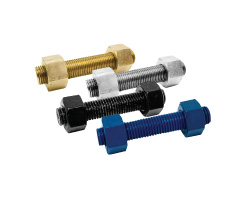
Stud Bolts
A Stud Bolt is made up of a cut piece of threaded rod and two heavy hex nuts screwed on to either end. Stud Bolts are used in the industry to properly seal flanged joints. Stud Bolts can also be coated to increase their resistance to corrosion in certain applications.
Flanges require a specific size and number bolts depending on the size and pressure class of the flange. The size and number of bolts needed can be determined by consulting the ASME flange bolt chart. Nuts are tightened to a specific torque depending on the application. Stud Bolts are manufactured in accordance with ASME B16.5.
Stud Bolt Coatings
- Blue FPC
- Cadmium Yellow
- Cadmium White
- Hot Dipped Galvanized
- Mechanical Galvanized
- Zinc White
- Zinc Yellow
Common Stud Bolt Grades
- B7
- B7M
- B8
- B8M
- B16
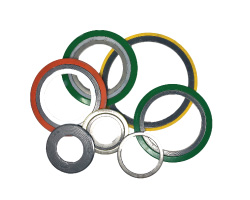
Gaskets
Gaskets are used between two flanges to create a seal. When compressed gaskets fill in small imperfections in the flange face creating a leak-free seal. The application, pressure, temperature and media will help to determine the type of gasket needed.
Gaskets can be supplied in various sizes and pressure classes for any application. Gaskets are manufactured in accordance with ASME B16.20 and ASME B16.21.
Gasket Types
- Cut Ring
- Corrugated Metal
- Full Face
- Heat Exchanger
- High Temperature
- Kammprofile
- Metal Jacketed
- Ring Type Joint
- Spiral Wound (with and without inner ring)
Common Gasket Materials
- Compressed Non-Asbestos Sheet
- PTFE Sheet
- Flexible Graphite
- Mica
- Stainless Steel
- Carbon Steel
- Rubber
